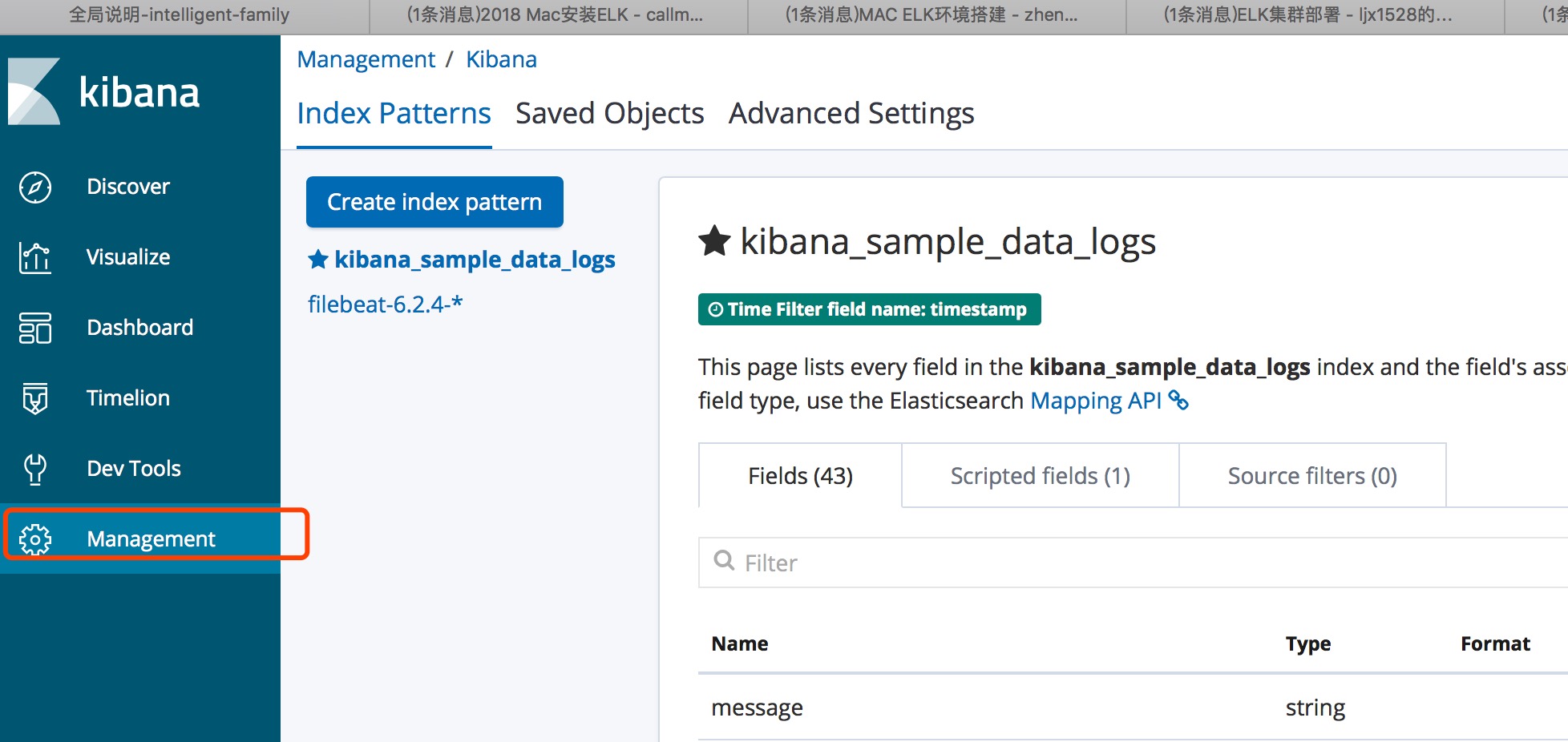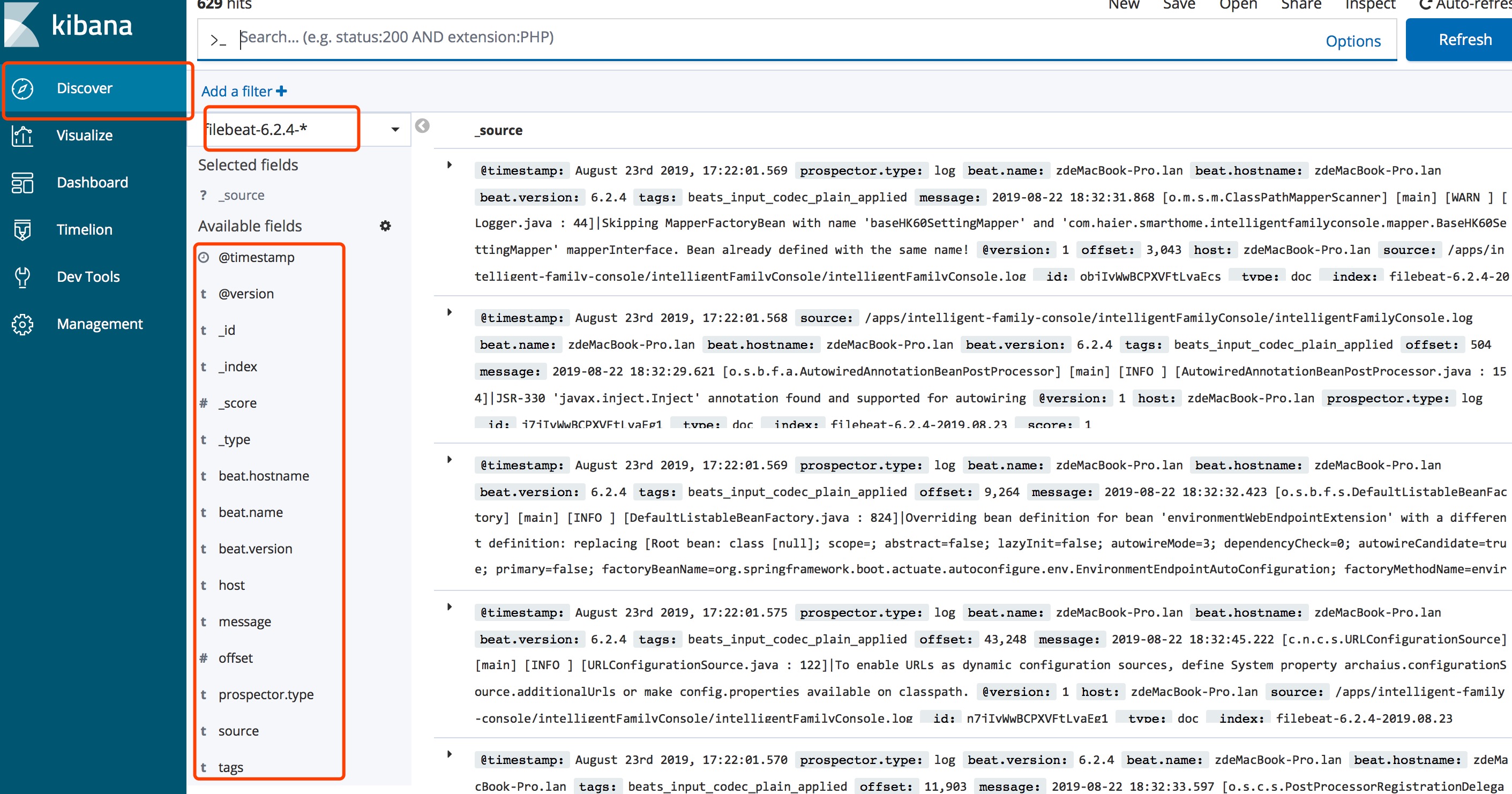ElkStack-MACOS搭建
简介
Elasticsearch
Elasticsearch是一个实时的分布式搜索分析引擎, 它能让你以一个之前从未有过的速度和规模,去探索你的数据。它被用作全文检索、结构化搜索、分析以及这三个功能的组合。支持集群配置。
Logstash/Filebeats
Logstash是一款强大的数据处理工具,它可以实现数据传输,格式处理,格式化输出,还有强大的插件功能,常用于日志处理。。
Kibana
kibana是一个开源和免费的工具,它可以为Logstash和ElasticSearch提供的日志分析友好的Web界面,可以帮助您汇总、分析和搜索重要数据日志。
架构流程

安装配置
版本
Elasticsearch
Logstash
Kibana
Filebeats
先决条件
java8
mac软件管理工具 brew
brew
# 安装软件
brew install your-software
# 查看软件安装信息
brew info your-software
# 管理服务,没怎么用它,ELK都有自己的启动脚本在安装目录的bin/下面,且基本上都会携带参数启动
brew services start/stop your-service
Elasticsearch
mac安装elasticsearch
#mac安装elasticsearch
brew install elasticsearch
elasticsearch的相关安装位置
安装目录:/usr/local/Cellar/elasticsearch/{elasticsearch-version}/
日志目录:/usr/local/var/log/elasticsearch/
插件目录:/usr/local/var/elasticsearch/plugins/
配置目录:/usr/local/etc/elasticsearch/
启动
brew services start elasticsearch
首次启动,默认的端口号是9200,用户名是elastic,密码我也不知道(资料上查到的都是6.0以前的版本,密码是changeme,6.0以后不清楚),通过调用_xpack接口修改默认密码:
版本
elasticsearch --version
Version: 6.6.1, Build: oss/tar/1fd8f69/2019-02-13T17:10:04.160291Z, JVM: 1.8.0_131
Kibana
mac安装kibana
brew install kibana
安装位置
安装目录:/usr/local/Cellar/kibana/{kibana-version}/
配置目录:/usr/local/etc/kibana/
备注
启动kibana之前,需要先修改一下配置文件/usr/local/etc/kibana/kibana.yml,取消elasticsearch.name和elasticsearch.password的注释,并将值改为上面修改过的用户名密码username: elastic, password: 123456,请参考下面的kibana.yml片段
# kibana.yml
# If your Elasticsearch is protected with basic authentication, these settings provide
# the username and password that the Kibana server uses to perform maintenance on the Kibana
# index at startup. Your Kibana users still need to authenticate with Elasticsearch, which
# is proxied through the Kibana server.
elasticsearch.username: "elastic"
elasticsearch.password: "changeme"
启动
brew services start kibana
首次启动,默认端口号是5601,打开浏览器访问http://localhost:5601访问kibana管理页面,会弹框要求输入用户名密码,输入elastic和123456即可。
注:这里的kibana.yml中配置的用户名密码是kibana访问elasticsearch需要用到的,而web页面手动输入的用户名密码是我们登录kibana管理页面的密码,它们为什么能共用一个密码,不太清楚。
版本
kibana --version
6.6.1
Logstash
mac安装logstash
brew install logstash
logstash的相关安装位置
安装目录:/usr/local/Cellar/logstash/{logstash-version}/
配置目录:/usr/local/etc/logstash
配置
vim ./first-pipeline.conf
- 支持Filebeat作为输入源
# Sample Logstash configuration for creating a simple
# Beats -> Logstash -> Elasticsearch pipeline.
input {
beats {
host =>"127.0.0.1"
port => "5044"
}
}
output {
elasticsearch {
hosts => ["http://localhost:9200"]
index => "%{[@metadata][beat]}-%{[@metadata][version]}-%{+YYYY.MM.dd}"
#user => "elastic"
#password => "changeme"
}
}
- logstash 配置文件输入支持文件输入,例如:
[root@access-1 logstash-7.2.1]# cat logstash_809.conf
input {
file{
path => ['/opt/access-server-1.0.5/log/akka-gb809.log'] #读取日志文件路径
type => "akka-gb809" #一个标签
stat_interval => "2" #每隔几秒读取日志文件,默认为1秒
}
file{
path => ['/opt/access-server-1.0.5/log/akka-gb808.log']
type => "akka-gb808"
stat_interval => "2"
}
file{
path => ['/opt/access-server-1.0.5/log/akka.log']
type => "akka"
stat_interval => "2"
}
file{
path => ['/opt/access-server-1.0.5/log/all_error.log']
type => "all_error"
stat_interval => "2"
codec => multiline { #将换行的日志打印出来
pattern => "(^\d{2}\:\d{2}\:\d{2}\.\d{3})UTC" #匹配的正则
negate => true
what => "previous"
}
}
}
filter {
date {
match => [ "timestamp" , "yyyy-MM-dd HH:mm:ss.SSS" ]
}
}
output {
if [type] == "akka-gb809" { #要匹配的日志文件标签
elasticsearch {
hosts => "192.168.108.151:9200" #es节点地址
index => "access-1-akka-gb809" #生成的索引,用于kibana展示
}
}
if [type] == "akka-gb808" {
elasticsearch {
hosts => "192.168.108.151:9200"
index => "access-1-akka-gb808"
}
}
if [type] == "akka" {
elasticsearch {
hosts => "192.168.108.151:9200"
index => "access-1-akka"
}
}
if [type] == "all_error" {
elasticsearch {
hosts => "192.168.108.151:9200"
index => "access-1-all_error"
}
}
}
启动
logstash -e 'input { stdin { } } output { stdout {} }'
或
logstash -f config/first-pipeline.conf --config.test_and_exit
此条命令检验配置文件是否正确
logstash -f config/first-pipeline.conf --config.reload.automatic
此条命令是启动logstash,并且在first-pipeline.conf文件变更时自动重启。
后台启动
nohup logstash -f config/first-pipeline.conf --config.reload.automatic & > /dev/null
版本
logstash 6.6.1
Filebeats'
安装
#mac安装Filebeats'
brew install filebeat
位置
安装目录:/usr/local/Cellar/filebeat/{filebeat-version}/
配置目录:/usr/local/etc/filebeat/
缓存目录:/usr/local/var/lib/filebeat/
配置
vim /usr/local/etc/filebeat//filebeat.yml
###################### Filebeat Configuration Example #########################
# This file is an example configuration file highlighting only the most common
# options. The filebeat.reference.yml file from the same directory contains all the
# supported options with more comments. You can use it as a reference.
#
# You can find the full configuration reference here:
# https://www.elastic.co/guide/en/beats/filebeat/index.html
# For more available modules and options, please see the filebeat.reference.yml sample
# configuration file.
#=========================== Filebeat prospectors =============================
filebeat.prospectors:
# Each - is a prospector. Most options can be set at the prospector level, so
# you can use different prospectors for various configurations.
# Below are the prospector specific configurations.
- type: log
# Change to true to enable this prospector configuration.
enabled: true
# Paths that should be crawled and fetched. Glob based paths.
paths:
- /apps/intelligent-family-console/intelligentFamilyConsole/*.log
#- c:\programdata\elasticsearch\logs\*
# Exclude lines. A list of regular expressions to match. It drops the lines that are
# matching any regular expression from the list.
#exclude_lines: ['^DBG']
# Include lines. A list of regular expressions to match. It exports the lines that are
# matching any regular expression from the list.
#include_lines: ['^ERR', '^WARN']
# Exclude files. A list of regular expressions to match. Filebeat drops the files that
# are matching any regular expression from the list. By default, no files are dropped.
#exclude_files: ['.gz$']
# Optional additional fields. These fields can be freely picked
# to add additional information to the crawled log files for filtering
#fields:
# level: debug
# review: 1
### Multiline options
# Mutiline can be used for log messages spanning multiple lines. This is common
# for Java Stack Traces or C-Line Continuation
# The regexp Pattern that has to be matched. The example pattern matches all lines starting with [
#multiline.pattern: ^\[
# Defines if the pattern set under pattern should be negated or not. Default is false.
#multiline.negate: false
# Match can be set to "after" or "before". It is used to define if lines should be append to a pattern
# that was (not) matched before or after or as long as a pattern is not matched based on negate.
# Note: After is the equivalent to previous and before is the equivalent to to next in Logstash
#multiline.match: after
#============================= Filebeat modules ===============================
filebeat.config.modules:
# Glob pattern for configuration loading
path: ${path.config}/modules.d/*.yml
# Set to true to enable config reloading
reload.enabled: false
# Period on which files under path should be checked for changes
#reload.period: 10s
#==================== Elasticsearch template setting ==========================
setup.template.settings:
index.number_of_shards: 3
#index.codec: best_compression
#_source.enabled: false
#================================ General =====================================
# The name of the shipper that publishes the network data. It can be used to group
# all the transactions sent by a single shipper in the web interface.
#name:
# The tags of the shipper are included in their own field with each
# transaction published.
#tags: ["service-X", "web-tier"]
# Optional fields that you can specify to add additional information to the
# output.
#fields:
# env: staging
#============================== Dashboards =====================================
# These settings control loading the sample dashboards to the Kibana index. Loading
# the dashboards is disabled by default and can be enabled either by setting the
# options here, or by using the `-setup` CLI flag or the `setup` command.
#setup.dashboards.enabled: false
# The URL from where to download the dashboards archive. By default this URL
# has a value which is computed based on the Beat name and version. For released
# versions, this URL points to the dashboard archive on the artifacts.elastic.co
# website.
#setup.dashboards.url:
#============================== Kibana =====================================
# Starting with Beats version 6.0.0, the dashboards are loaded via the Kibana API.
# This requires a Kibana endpoint configuration.
setup.kibana:
# Kibana Host
# Scheme and port can be left out and will be set to the default (http and 5601)
# In case you specify and additional path, the scheme is required: http://localhost:5601/path
# IPv6 addresses should always be defined as: https://[2001:db8::1]:5601
#host: "localhost:5601"
#============================= Elastic Cloud ==================================
# These settings simplify using filebeat with the Elastic Cloud (https://cloud.elastic.co/).
# The cloud.id setting overwrites the `output.elasticsearch.hosts` and
# `setup.kibana.host` options.
# You can find the `cloud.id` in the Elastic Cloud web UI.
#cloud.id:
# The cloud.auth setting overwrites the `output.elasticsearch.username` and
# `output.elasticsearch.password` settings. The format is `<user>:<pass>`.
#cloud.auth:
#================================ Outputs =====================================
# Configure what output to use when sending the data collected by the beat.
#-------------------------- Elasticsearch output ------------------------------
#output.elasticsearch:
# Array of hosts to connect to.
#hosts: ["localhost:9200"]
# Optional protocol and basic auth credentials.
#protocol: "https"
#username: "elastic"
#password: "changeme"
#----------------------------- Logstash output --------------------------------
output.logstash:
# The Logstash hosts
hosts: ["localhost:5044"]
# Optional SSL. By default is off.
# List of root certificates for HTTPS server verifications
#ssl.certificate_authorities: ["/etc/pki/root/ca.pem"]
# Certificate for SSL client authentication
#ssl.certificate: "/etc/pki/client/cert.pem"
# Client Certificate Key
#ssl.key: "/etc/pki/client/cert.key"
#================================ Logging =====================================
# Sets log level. The default log level is info.
# Available log levels are: error, warning, info, debug
logging.level: debug
# At debug level, you can selectively enable logging only for some components.
# To enable all selectors use ["*"]. Examples of other selectors are "beat",
# "publish", "service".
#logging.selectors: ["*"]
#============================== Xpack Monitoring ===============================
# filebeat can export internal metrics to a central Elasticsearch monitoring
# cluster. This requires xpack monitoring to be enabled in Elasticsearch. The
# reporting is disabled by default.
# Set to true to enable the monitoring reporter.
#xpack.monitoring.enabled: false
# Uncomment to send the metrics to Elasticsearch. Most settings from the
# Elasticsearch output are accepted here as well. Any setting that is not set is
# automatically inherited from the Elasticsearch output configuration, so if you
# have the Elasticsearch output configured, you can simply uncomment the
# following line.
#xpack.monitoring.elasticsearch:
主要是配置filebeat.inputs,采集哪些日志;关闭output.elasticsearch,打开output.logstash,将收集到的信息推送到logstash。
启动
filebeat -e -c ./filebeat6.3.2/filebeat.yml
或
nohup filebeat -e -c ./filebeat6.3.2/filebeat.yml & >/dev/null
版本
filebeat --version
lag --version has been deprecated, version flag has been deprecated, use version subcommand
filebeat version 6.2.4 (amd64), libbeat 6.2.4
Kibana案例
创建Index patterns

检索界面
- 左侧为可检索条件

后续跟进
日志定时删除问题
Elasticsearch集群部署
下载解压
wget https://artifacts.elastic.co/downloads/elasticsearch/elasticsearch-7.2.1-linux-x86_64.tar.gz
tar -zvxf elasticsearch-7.2.1-linux-x86_64.tar.gz -C /usr/local/elk
创建用户及授权
ElasticSerach要求以非root身份启动,在每个节点创建用户及用户组
[root@elk-1 ~]# groupadd elasticsearch
[root@elk-1 ~]# useradd elasticsearch -g elasticsearch
在每个节点上创建数据data和logs目录:
[root@elk-1 ~]# mkdir -p /data/elasticsearch/{data,logs}
[root@elk-1 ~]# chown -R elasticsearch. /data/elasticsearch/
[root@elk-1 ~]# chown -R elasticsearch. /home/elk/elasticsearch/elasticsearch-7.2.1
修改elasticsearch.yml配置文件
- master节点配置文件
[root@elk-1 config]# grep -Ev "^$|^[#;]" elasticsearch.yml
cluster.name: master-node
node.name: master
node.master: true
node.data: true
http.cors.enabled: true
http.cors.allow-origin: /.*/
path.data: /home/elk/data
network.host: 0.0.0.0
http.port: 9200
discovery.seed_hosts: ["192.168.108.151", "192.168.108.152", "192.168.108.153"]
cluster.initial_master_nodes: ["master", "data-node1","data-node2"]
- node1节点配置文件
[root@elk-2 config]# grep -Ev "^$|^[#;]" elasticsearch.yml
cluster.name: master-node
node.name: data-node1
node.master: true
node.data: true
path.data: /home/elk/data
network.host: 0.0.0.0
http.port: 9200
discovery.seed_hosts: ["192.168.108.151", "192.168.108.152", "192.168.108.153"]
cluster.initial_master_nodes: ["master-node", "data-node1","data-node2"]
- node2节点配置文件
[root@elk-3 config]# grep -Ev "^$|^[#;]" elasticsearch.yml
cluster.name: master-node
node.name: data-node2
node.master: true
node.data: true
path.data: /home/elk/data
network.host: 0.0.0.0
http.port: 9200
discovery.seed_hosts: ["192.168.108.151", "192.168.108.152", "192.168.108.153"]
cluster.initial_master_nodes: ["master", "data-node1","data-node2"]
- 修改elasticsearch的JVM内存
[root@elk-1 config]# grep -Ev "^$|^[#;]" jvm.options -Xms1g -Xmx1g
- 启动elasticsearch
[root@ELK1 elk]# su - elasticsearch
Last login: Mon Aug 12 09:58:23 CST 2019 on pts/1
[elasticsearch@ELK1 ~]$ cd /home/elk/elasticsearch-7.2.1/bin/
[elasticsearch@ELK1 bin]$ ./elasticsearch -d
- 查看端口号,分别为9200和9300
[root@elk-1 config]# ss -tlunp|grep java
tcp LISTEN 0 128 :::9200 :::* users:(("java",pid=50257,fd=263))
tcp LISTEN 0 128 :::9300 :::* users:(("java",pid=50257,fd=212))
- es集群基本操作
#查看集群的健康信息
curl 'localhost:9200/_cluster/health?pretty'
#查看集群的详细信息
curl ' localhost:9200/_cluster/state?pretty'
#查询索引列表
curl -XGET http:// localhost:9200/_cat/indices?v
#创建索引
curl -XPUT http:// localhost:9200/customer?pretty
#查询索引
curl -XGET http:// localhost:9200/customer/external/1?pretty
#删除索引
curl -XDELETE http:// localhost:9200/customer?pretty
#删除指定索引
curl -XDELETE localhost:9200/nginx-log-2019.08
#删除多个索引
curl -XDELETE localhost:9200/system-log-2019.0606,system-log-2019.0607
#删除所有索引
curl -XDELETE localhost:9200/_all
#在删除数据时,通常不建议使用通配符,误删后果会很严重,所有的index都可能被删除,为了安全起见需要禁止通配符,可以在elasticsearch.yml配置文件中设置禁用_all和*通配符
action.destructive_requires_name: true
Elasticsearch Head插件
参考
https://blog.csdn.net/ljx1528/article/details/100031330
https://blog.csdn.net/zhengdesheng19930211/article/details/80249919
https://blog.csdn.net/callmepls1/article/details/79441505
http://www.mamicode.com/info-detail-2344537.html
https://blog.csdn.net/Ahri_J/article/details/79609444
https://www.dgstack.cn/archives/2363.html
https://www.jqhtml.com/49585.html
ElkStack-MACOS搭建的更多相关文章
- MacOS搭建本地服务器
MacOS搭建本地服务器 一,需求分析 1.1,开发app(ios android)时通常需往app中切入web页面,直接导入不行,故需搭建本地的测试网站服务,通过IP嵌入访问页面. 1.2,开发小程 ...
- macOS搭建开发环境
1.包管理器Homebrew使用下面的命令安装: ruby -e "$(curl -fsSL https://raw.githubusercontent.com/Homebrew/insta ...
- macOS搭建Hugo
Hugo 是一个用Go语言编写的静态网站生成器.类似的静态网站生成器还有Jekyll.hexo等等. Hugo官方主页:https://gohugo.io/ 1.安装homebrew: https:/ ...
- 搭建一个舒适的 .NET Core 开发环境
最近,一直在往.Net Core上迁移,随着工作的深入,发现.Net Core比.Net Framework好玩多了.不过目前还在windows下开发,虽然VisualStudio是宇宙第一神器,但是 ...
- NET Core 开发环境
NET Core 开发环境 最近,一直在往.Net Core上迁移,随着工作的深入,发现.Net Core比.Net Framework好玩多了.不过目前还在windows下开发,虽然VisualSt ...
- K8s 开始
Kubernetes 是用于自动部署,扩展和管理容器化应用程序的开源系统.本文将介绍如何快速开始 K8s 的使用. 了解 K8s Kubernetes / Overview 搭建 K8s 本地开发测试 ...
- 在macOS Sierra 10.12搭建PHP开发环境
macOS Sierra 11.12 已经帮我们预装了 Ruby.PHP(5.6).Perl.Python 等常用的脚本语言,以及 Apache HTTP 服务器.由于 nginx 既能作为 HTTP ...
- Redis环境搭建(MacOS)
Redis是一个开源的key-value类型的存储系统,大部分数据存在于内存中,所有读写速度十分快.其支持的存储value数据类型有多种,如:strings.hashes.lists.sets.sor ...
- MacOS下Rails+Nginx+SSL环境的搭建(上)
这里把主要的步骤写下来,反正我是走了不少弯路,希望由此需求的朋友们别再走类似的弯路.虽说环境是在MacOS下搭建,但是基本上和linux下的很相像,大家可以举一反三. 一.安装Rails 这个是最简单 ...
- AI应用开发实战 - 从零开始搭建macOS开发环境
AI应用开发实战 - 从零开始搭建macOS开发环境 本视频配套的视频教程请访问:https://www.bilibili.com/video/av24368929/ 建议和反馈,请发送到 https ...
随机推荐
- 用webpack给js添加上版本号
在网上查找了很多的资料. 都没有好的资源 因为我现在在项目是vuecli3.0 需要自己去创建文件 在项目的根目录下,创建一个文件vue.config.js 然后在该文件下写 const webpac ...
- vue混入mixin
<div id="app"> --{{nick11}} </div> <script> // 全局混入 不需要注册 var m1 = Vue.m ...
- SqlSugar分组查询
一.分组查询和使用 1.1 语法 只有在聚合对象需要筛选的时候才会用到Having,一般分组查询用不到可以去掉 var list = db.Queryable<Student>() ...
- 7.2 C/C++ 实现动态链表
动态链表是一种常用的动态数据结构,可以在运行时动态地申请内存空间来存储数据,相比于静态数组和静态链表,更加灵活和高效.在动态链表中,数据元素被组织成一条链表,每个元素包含了指向下一个元素的指针,这样就 ...
- STM32CubeMX教程30 USB_DEVICE - MSC外设_读卡器
1.准备材料 正点原子stm32f407探索者开发板V2.4 STM32CubeMX软件(Version 6.10.0) keil µVision5 IDE(MDK-Arm) ST-LINK/V2驱动 ...
- (C语言)每日代码||2023.12.24||fwrite()可以写入字符数组中的'\0'
void test() { FILE* fp = fopen("test.txt", "w"); if (fp == NULL) { perror(" ...
- 哈希表(HashMap)与字符串哈希
哈希表 哈希表是一种通过映射来快速查找的数据结构.其通过键值对(key-value)来存储.一个数据通过哈希函数的运算来生成一个属于他自己的键值,尔后将其与键值绑定.当我们想查找这个数据时,就可以直接 ...
- 关于 javax.validation.constraints 的测试,以后用到的 会继续补充
参见:https://www.cnblogs.com/xiaogangfan/p/5987659.html 1.@Size注解测试:
- .NET 云原生架构师训练营(模块二 基础巩固 Scrum 简介)--学习笔记
2.7.2 Scrum 简介 SCRUM 是什么 SCRUM 精髓 SCRUM 框架 角色 SCRUM 是什么 SCRUM 是迄今为止最著名的敏捷方法,主要用于开发.交付和持续支持复杂产品的一个框架, ...
- webpack学习笔记(一)安装与试用
由于初次接触 webpack(官网),对很多方面都不是很理解,在查找部分资料后记录一下自己的见解(本文实践基于webpack4). 1. 个人见解 简单来说,webpack就是js的 打包 工具.个人 ...
